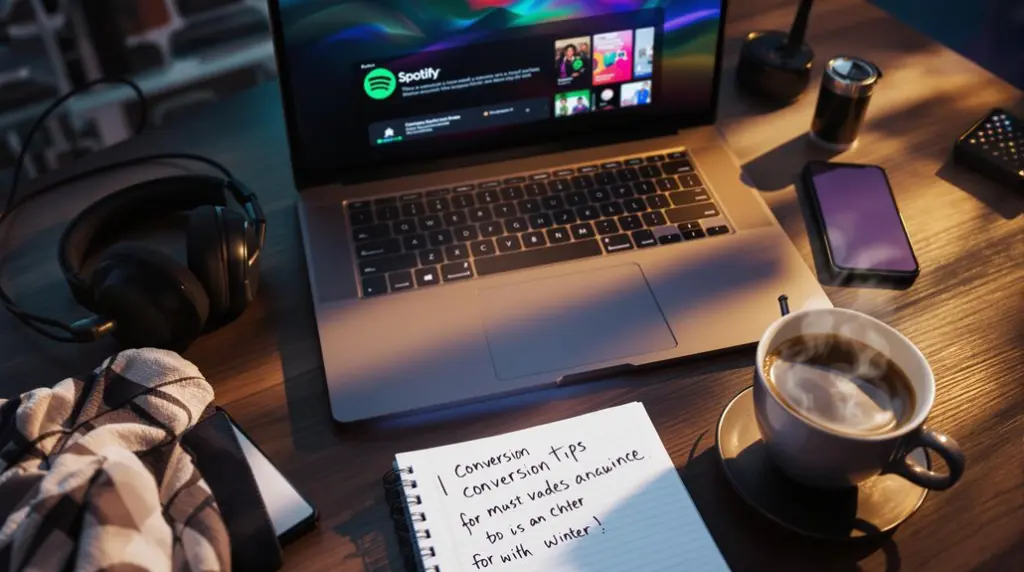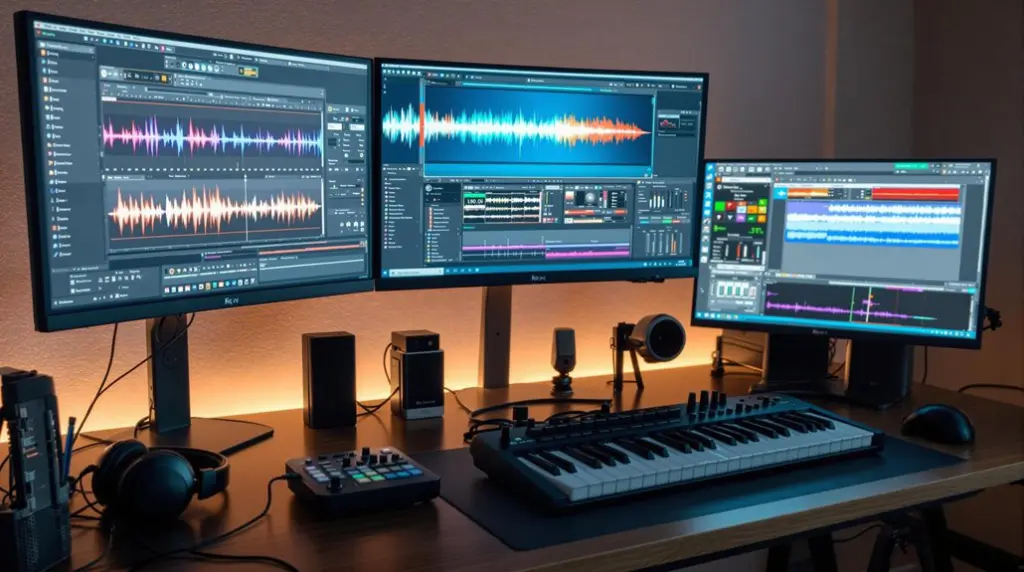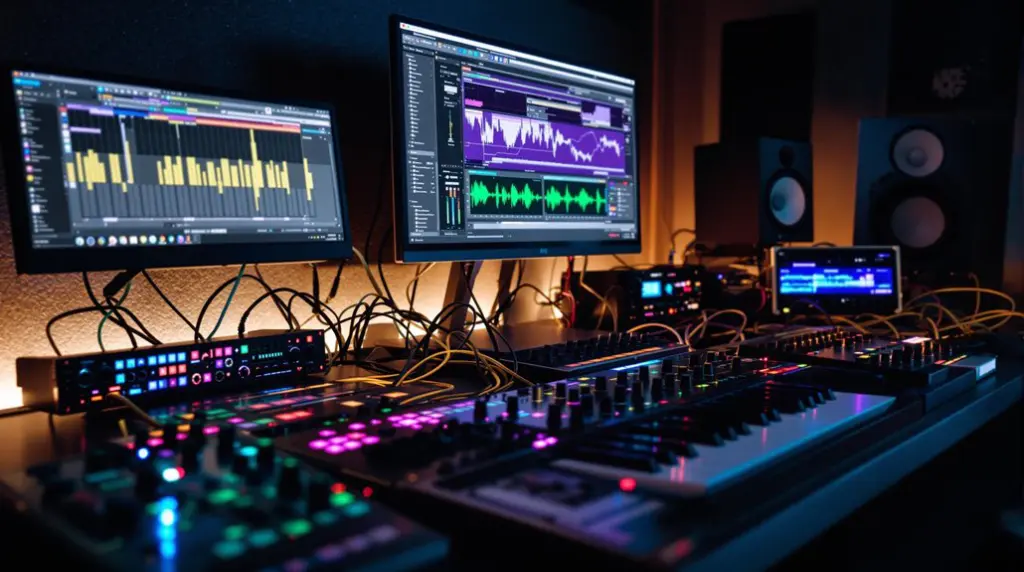To troubleshoot crackling in your studio monitors, start by checking all wire connections for security and any signs of wear. Inspect your audio source and confirm compatibility, then test it on another system. Examine the power supply for fluctuations and try using a power conditioner. Test different high-quality XLR and power cables to guarantee signal integrity. Clean and maintain all connectors, and eliminate any potential electrical interference from nearby devices. If you suspect internal issues, carefully inspect circuit boards and components. If these steps don’t resolve the problem, professional assistance might be necessary. You’ll find more detailed steps in the guide.
Key Takeaways
- Ensure all wire connections between the audio source, monitors, and power supply are secure and free from wear or grounding issues.
- Test your audio source on a different system to isolate and verify the problem’s origin.
- Use high-quality XLR and power cables, experimenting with different lengths and brands to identify the crackling source.
- Keep electronic devices like routers and microwaves away to minimize electromagnetic interference in your studio setup.
- Check internal components like circuit boards and capacitors for faults, and replace any defective parts to resolve crackling sounds.
Check Wire Connections
Begin troubleshooting crackling in your studio monitors by verifying all wire connections are securely plugged in. Start with the cables linking your audio source, monitors, and power supply. Proper cable management is critical; tangled or poorly organized cables can degrade signal quality and introduce noise. Confirm each cable is firmly connected and shows no signs of wear or damage.
Next, inspect the cables for potential grounding issues. Poor grounding can cause interference and crackling sounds. Use high-quality, shielded cables to reduce signal interference and maintain peak signal quality. Shielded cables provide proper insulation, preventing external noise from affecting your audio.
Check the internal connections within your monitors. Loose components or solder breakdowns can disrupt the signal path, causing crackling noises. If you’re comfortable opening your monitors, ensure all internal connections are intact and secure.
If you identify any damaged or loose cables, replace them immediately to avoid further issues. High-quality cables not only enhance signal quality but also offer better durability and insulation, essential for reducing unwanted noise.
If these steps don’t resolve the issue, seek professional assistance to diagnose and address any complex wiring problems affecting your studio monitors.
Inspect Audio Source
Having checked the wire connections, the next step is to confirm that the audio source is securely connected to the monitor inputs. Start by inspecting the audio cables for any signs of damage or wear. Loose or frayed cables can introduce noise and interfere with signal quality. Make sure the connections are secure and free from corrosion or debris.
Next, check the signal by testing the audio source on a different system. This helps determine if the problem lies with the source or the monitors. If the issue persists on another system, the audio source may need repair or replacement.
Verify compatibility between your audio source and studio monitors. Confirm that the output settings on the source device match the input requirements of the monitors. Incorrect settings can cause audio issues, including crackling. Access the source device’s audio settings and confirm they’re configured correctly for monitor output.
Lastly, examine the audio source connectors for visible damage. Bent or broken connectors can disrupt the signal and lead to poor audio quality. Addressing these potential issues early can save time and prevent further complications in your troubleshooting process.
Examine Power Supply
Check the power supply for fluctuations or inconsistencies that could be causing the crackling in your studio monitors. Verify the power source is stable and provides adequate voltage regulation. Unstable power can introduce noise, leading to crackling sounds. Examine the power supply cables for any signs of damage, as frayed or worn cables can compromise power stability.
To guarantee peak performance, consider using a power conditioner or surge protector. These devices can help regulate voltage and protect your equipment from power spikes that might cause audio issues. Testing your studio monitors with an alternative power source can also help identify if the current power supply is the root cause of the problem.
Here’s a quick checklist to guide you:
| Step | Action |
|---|---|
| 1 | Check for power supply fluctuations. |
| 2 | Examine power supply cables for damage. |
| 3 | Use a power conditioner or surge protector. |
| 4 | Test monitors with a different power source. |
| 5 | Verify stable and sufficient power. |
Test Different Cables
Testing different cables can help determine whether faulty connections are causing the crackling in your studio monitors. Start by swapping your current XLR and power cables with high-quality, balanced alternatives. This guarantees excellent signal transmission and minimizes interference that can lead to crackling. When you compare cable performance, observe if the crackling persists or diminishes.
Evaluate signal quality by experimenting with various cable lengths and brands. Use shorter, well-shielded cables to see if they provide a clearer signal. Poorly shielded or excessively long cables often introduce noise that can exacerbate crackling.
Clean Connections
To guarantee excellent audio quality and eliminate crackling, start by securing all cable connections to both the monitor and the audio interface. Begin with a visual inspection of the cables and connectors, ensuring they’re firmly in place. Loose connections can severely impact signal clarity, introducing unwanted noise into your audio setup.
Next, focus on contact cleaning to enhance audio quality. Use contact cleaner or compressed air to remove dust and debris from the input jacks. Dust accumulation can interfere with proper connectivity, leading to crackling sounds. If you notice any corrosion on the connectors, clean them with a suitable solution. Corrosion hampers signal transfer, degrading audio performance.
Pay attention to the physical state of your connections. Tighten any loose screws or connections on the monitors. Loose hardware can create poor contact points, which are an important source of crackling.
Regular connection maintenance is essential; periodically inspect and maintain your cables and connections to avoid future audio issues.
Update Drivers and Firmware
Updating the drivers and firmware of your studio monitors can greatly enhance their performance and resolve crackling issues. Start by visiting the manufacturer’s website to check for the latest audio driver updates specific to your monitor model. Download and install these updates to guarantee peak performance improvements. Firmware updates are equally important as they can address audio crackling by enhancing firmware compatibility with your system.
Follow the manufacturer’s instructions carefully to avoid potential issues during the update process. Regularly checking for updates ensures your studio monitors run on the most stable and efficient software versions available.
Here’s a concise guide to streamline the update process:
| Step | Action | Notes |
|---|---|---|
| 1. Check for updates | Visit the manufacturer’s website | Look for model-specific updates |
| 2. Download updates | Get the latest drivers and firmware | Verify the files are correct |
| 3. Install updates | Follow manufacturer instructions | Prevent interruptions during the update |
Keeping your drivers and firmware up-to-date not only resolves crackling issues but also optimizes the overall functionality of your studio monitors. These updates contribute to better firmware compatibility and significant performance improvements, ensuring a smoother, more reliable audio experience.
Isolate Electrical Interference
Minimizing electrical interference is essential for preserving the pristine audio quality of your studio monitors. Start by using shielded cables, which are designed to reduce the impact of external electromagnetic interference.
Properly grounded equipment is vital; confirm all your devices are connected to a common grounding point to prevent ground loops that can cause persistent crackling noises.
Invest in surge protectors to safeguard your equipment from voltage spikes that can introduce noise. For better protection and noise filtration, consider using power conditioners. They not only protect against surges but also filter out electrical noise from the power supply, ensuring clean, stable power for your monitors.
Keep noisy appliances like refrigerators, microwaves, and fluorescent lights away from your studio setup, as they can emit electrical interference.
Test different power sources to determine if a particular outlet is causing issues. If your monitors have a ground lift switch, use it to address ground loop problems and reduce any resultant interference.
Inspect Internal Components
After addressing potential electrical interference, it’s important to inspect the internal components of your studio monitors to identify any hardware issues that might be causing the crackling sounds. Start by opening the housing and examining the circuit board thoroughly. Check solder joints for any signs of cracks or poor connections, as these can often be the culprit behind intermittent audio issues.
Next, monitor temperature by inspecting the amplifier chip. Overheating can lead to crackling sounds, so make sure the heat sink is functioning properly. If needed, apply new thermal paste to improve heat dissipation. Pay close attention to electrolytic capacitors, as dried-out capacitors can also cause audio distortions. Replace any capacitors that look bulged or discolored.
It’s also essential to evaluate IC-based components like amplifiers, which can degrade over time and result in crackling noises. Make sure these components are functioning correctly and replace them if necessary.
Seek Professional Help
When your troubleshooting efforts fail to resolve the crackling in your studio monitors, seeking professional help becomes essential. Technicians possess the expertise and specialized equipment needed to accurately diagnose and fix complex issues that may elude your own diagnostic attempts. They can pinpoint the exact cause of the crackling, whether it’s an internal component failure or an intricate wiring issue.
Considering repair costs is important when opting for professional assistance. While professional services might seem costly upfront, they can ultimately save you money by preventing further damage and extending the lifespan of your monitors. Additionally, many technicians offer tailored solutions based on the specific make and model of your equipment, ensuring a precise and long-lasting fix.
Don’t forget to check your warranty coverage before seeking external help. If your studio monitors are still under warranty, the manufacturer may cover repair costs, greatly reducing your out-of-pocket expenses. Always consult your warranty documentation and contact the manufacturer to understand what’s covered and how to proceed.
Frequently Asked Questions
How Do You Fix a Crackling Studio Monitor?
First, check your cable management for any damaged or loose connections. Then, test with a different audio source. Adjust buffer settings in your DAW, clean components, and make sure your audio interface drivers and monitor software are updated.
How Do I Stop My Speakers From Crackling?
Verify your cable management and secure all connections. Confirm that the power supply isn’t shared with noisy appliances. Replace any damaged speaker wires, use shorter cables, and keep your DAC separate from the source to eliminate crackling.
How to Fix Static Sound on Monitor?
To fix static sound on your monitor, start with proper cable management to prevent interference. Also, check for ground loop issues by ensuring your equipment is properly grounded and consider using balanced cables to reduce noise.
What Causes Audio Crackling?
Audio crackling often stems from poor cable quality or power interference. Verify that your cables are undamaged and properly shielded. Additionally, avoid placing monitors near high-power devices to reduce interference and maintain sound integrity.
Conclusion
By following these steps, you can systematically identify and resolve the crackling issues in your studio monitors.
Verify all connections are secure, inspect your audio source, and confirm your power supply.
Don’t forget to test different cables, clean connections, and update drivers and firmware.
Isolate any electrical interference, and if necessary, inspect internal components.
If the problem persists, seek professional help.
With careful troubleshooting, your monitors should soon be crackle-free.




